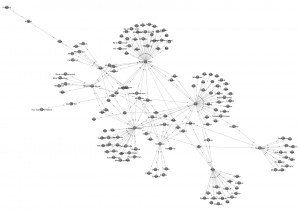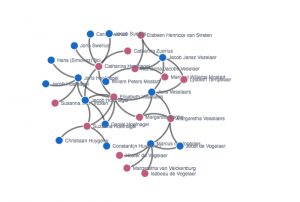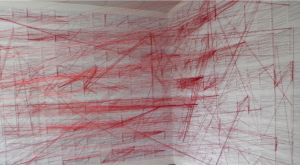In the 8th CREATE Salon, the topic of historical networks took centre stage. The three presenters all study historical networks in different ways. Jelma van Amersfoort, musician, musicologist and former database developer in the financial sector, views music-historical sources as forms of structured data that lends itself well to the use of computational techniques. Harm Nijboer, CREATE researcher and historical data specialist, uses the biographical Ecartico database to analyse kinship patterns in the cultural industry of early modern Amsterdam. And Bart Karstens, trained in the fields of history and computational linguistics and logics, employs network analysis to assess the level of complexity of legal documents.

Jelma van Amersfoort analysed a random sample of 36 letters by the famous composer Hector Berlioz (1803-1869), who is also known for his music-critical writings and his highly informative correspondence in which he makes mention of many people and inspirations. She found clear clusters of groups of people discussed by Berlioz in specific contexts (analysed with Gephi). If extended with more letters, such an endeavour would neatly present the socio-professional networks in which Berlioz was operating. Jelma’s second proof-of-concept used network analysis in a different way: to study the relational structure within a collection of musical scores. She subjected a set of twelve songs to network analysis in order to answer the question if the set should be seen as a cycle? This experiment showed new ways of considering and measuring connectedness and commonality in datasets, even if it is still early-stage research. In his analysis of the role of kinship relations in Amsterdam’s 17th-century cultural industry Harm Nijboer used the notion of networks as summaries of historical information or data. The Ecartico database allows for one-click visualizations of both the kinship-network of individuals in the dataset and a three-step network of all documented relations (including for instance that of master-pupil). Harm’s analysis revealed how kinship networks were used in different ways: in the upper echelons of Amsterdam’s cultural industry as a means of climbing the social ladders, and for producers of more modest means as an instrument to ensure continuity in the firm’s management. And obviously, women were crucial nodes in both strategies.

Both Jelma and Harm showed how cultural actors were embedded in distinct social and professional relations and how the network approach may be used to further analyse these relations in the future. Particularly interesting questions concern the qualifications of these relationships as well as their cause and consequences. What kind of information, knowledge and affections is found along the edges in the network? How were they received and mediated? What were the cause and consequence of specific relational structures? And in the case of creative industries, how do such economic, social, cultural and political structures facilitate or constrain creative and commercial action and by extension industrial trajectories? The presentation by Bart Karstens offered two useful tools with which to undertake more analytical research of historical networks: comparisons and hypotheses.

For his research in the project Legal Structures (Digging into Data Challenge) Bart uses a network analysis approach to analyse the complexity of legal texts, such as civil codes and constitutions. Such texts are characterized by internal referencing and balance a need for complexity and simplicity. Network analysis is used here as a means to analyze textual complexity and not as a goal in itself. Moreover, the researchers in the Legal Structures project depart from a specific set of hypotheses based on the assumption that texts from different countries and historical periods reflect different notions about legal systems and societal organization. By comparing the textual organization across different countries, and hopefully in the future also across different periods, different explanatory variables could be tested. And interestingly, Bart’s research also showed that referential complexity is not necessarily a bad thing, but that it may actually improve the legibility of (legal) texts.
At the basis of the three presentations lies the same assumption: actors (or other entities) are interdependent rather than independent. This fits perfectly with one of the defining features of contemporary creative industries: firms and workers in these industries are highly networked. This, of course, was no different in earlier periods and in recent years the use of networks in historical studies has moved well beyond mere metaphors. Not only social historians, but cultural, literary and art historians now employ network visualizations to study their research objects within their social, professional, cultural, and economic contexts. While this may seem obvious to many, implications could in fact be far-reaching, as it suggests that paintings, compositions and writings may be considered less as individual achievements than previously supposed. Moreover, network analysis can be an excellent means for tracing historical developments at the meso level. As Charles Tilly wrote several decades ago, the task of social history is: “a) documenting large structural changes, b) reconstructing the experiences of ordinary people in the course of those changes, c) connecting the two.” (Tilly, ‘Retrieving European lives’, p. 34). Network analysis can be a highly useful tool in realizing this ambition as long as researchers clearly articulate research questions and assumptions.
For more on Historical Network Analysis, please check out this website by Marten Düring and our workshop on June 19 2015.
